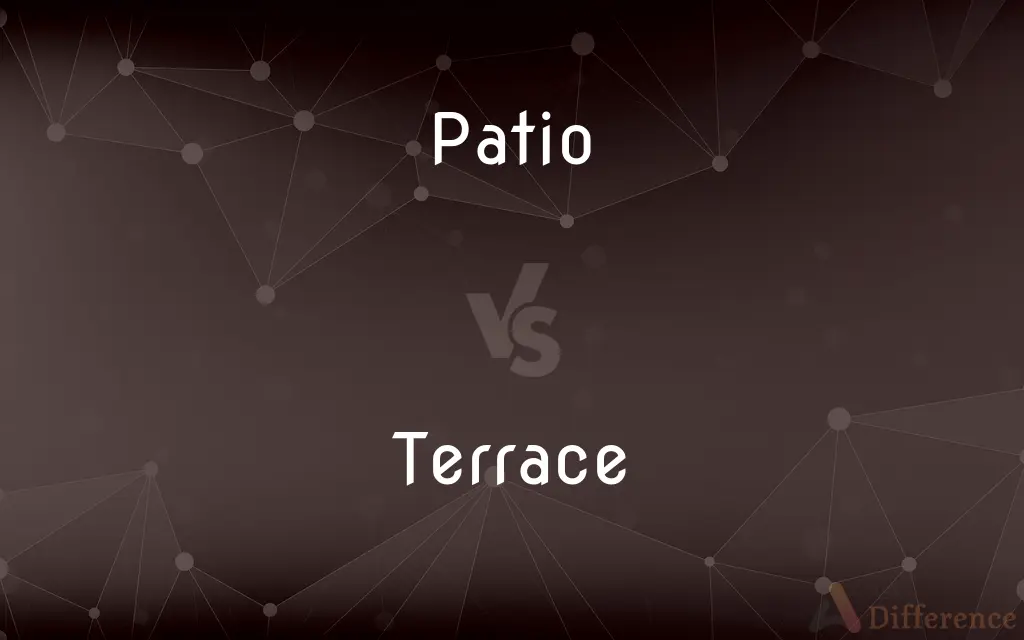Patio vs. Terrace — What's the Difference?
By Tayyaba Rehman & Fiza Rafique — Updated on March 12, 2024
A patio is a ground-level outdoor space used for dining or recreation, typically paved and adjoining a house. A terrace is an elevated flat area, sometimes part of a building or constructed on a natural slope, offering panoramic views and outdoor access.

Difference Between Patio and Terrace
Table of Contents
ADVERTISEMENT
Key Differences
Patios are designed as extensions of indoor living spaces, situated directly on the ground and usually made from materials like concrete, stone, bricks, or tiles. They often serve as areas for relaxation, outdoor dining, or entertainment, directly connected to the house, and can be enclosed by a garden or yard without any significant height difference from the surrounding land. In contrast, terraces are raised platforms that can be found as part of a building's architecture or constructed within a landscape to overcome sloped terrains.
The design and functionality of patios focus on enhancing the usability of outdoor home spaces, incorporating elements like furniture, fire pits, or barbeque setups to create comfortable living areas. Terraces, on the other hand, might emphasize the aesthetic integration with the environment, taking advantage of their height to offer unobstructed views and a sense of openness, often surrounded by balustrades or walls for safety.
While patios are generally more private, nestled into the home's landscape and designed for personal or family use, terraces can be found in both private residences and public buildings, such as hotels or apartments, where they provide communal spaces for enjoyment and relaxation. The construction of a patio usually involves ground-level work, including excavation and paving, making it relatively simpler and often less costly than building a terrace, which may require more significant architectural planning and support structures to ensure stability and safety on an elevated level.
The choice between a patio and a terrace often depends on the landscape, the desired use of the outdoor space, and personal preferences. While patios are versatile and easily customized to fit the style and needs of a home, terraces offer unique opportunities for enjoying elevated outdoor spaces, making the most of scenic landscapes and views.
Comparison Chart
Location
Ground level, adjoining a house
Elevated, part of a building or landscape
ADVERTISEMENT
Primary Use
Dining, recreation, relaxation
Outdoor enjoyment, scenic views
Construction
Paved with concrete, stone, bricks, or tiles
Built on natural or architectural elevations
Views
Limited by surrounding landscape
Offers panoramic or elevated views
Privacy
Generally more private
Can vary, often less private in public spaces
Cost
Generally less expensive
May require more investment due to structure
Accessibility
Direct access, no elevation
May require stairs or ramps
Typical Features
Furniture, fire pits, BBQ areas
Balustrades, gardens, seating areas
Compare with Definitions
Patio
Often enclosed by a garden or yard, enhancing privacy.
The patio was their private retreat, surrounded by lush greenery.
Terrace
An elevated flat area providing outdoor access and views.
The hillside villa's terrace offered breathtaking views of the valley.
Patio
A ground-level outdoor space for leisure next to a house.
They enjoyed summer barbeques on their brick-paved patio.
Terrace
Designed to integrate with the environment aesthetically.
The terrace was landscaped with native plants, blending with the surroundings.
Patio
Requires minimal architectural changes to the existing landscape.
Installing a patio involved laying pavers directly on the ground.
Terrace
Often surrounded by safety features like balustrades.
The rooftop terrace had glass balustrades for unobstructed city views.
Patio
Designed for comfort and usability, with outdoor furniture.
The patio featured comfortable seating and a fire pit for chilly evenings.
Terrace
Utilizes architectural planning for elevated outdoor space.
The architect designed the terrace to extend seamlessly from the living area.
Patio
Adaptable to various styles and sizes of homes.
Even the small house had a cozy patio for outdoor dining.
Terrace
Can be part of residential or commercial buildings.
The apartment building featured a communal terrace for residents.
Patio
A patio (, from Spanish: patio [ˈpatjo]; "courtyard", "forecourt", "yard") is an outdoor space generally used for dining or recreation that adjoins a residence and is typically paved. In Australia the term is expanded to include roofed structures such as a veranda, which provides protection from sun and rain.
Terrace
A level paved area next to a building; a patio
Breakfast is served on the terrace
Patio
An outdoor space for dining or recreation that adjoins a residence and is often paved.
Terrace
Each of a series of flat areas made on a slope, used for cultivation.
Patio
A roofless inner courtyard, typically found in Spanish and Spanish-style dwellings.
Terrace
A row of houses built in one block in a uniform style
An attractive Regency terrace
Patio
A paved outside area, adjoining a house, used for dining or recreation.
Terrace
Make or form (sloping land) into a number of level flat areas resembling a series of steps
The slope had to be terraced
Patio
An inner courtyard typical of traditional houses in some regions of Spain.
The flat looks out on a patio on one side and a churro café on on the other.
Terrace
A porch or walkway bordered by colonnades.
Patio
A paved yard or floor where ores are cleaned and sorted, or where ore, salt, mercury, etc., are trampled by horses, to effect intermixture and amalgamation.
Terrace
A platform extending outdoors from a floor of a house or apartment building.
Patio
In Spain, Spanish America, etc., a court or courtyard of a house or other building; esp., an inner court open to the sky.
Terrace
An open, often paved area adjacent to a house serving as an outdoor living space; a patio.
Patio
A usually paved area adjacent to a dwelling, used for outdoor lounging, dining, receptions of guests, etc.
Terrace
A raised bank of earth having vertical or sloping sides and a flat top
Turning a hillside into a series of ascending terraces for farming.
Patio
Usually paved outdoor area adjoining a residence
Terrace
A flat, narrow stretch of ground, often having a steep slope facing a river, lake, or sea.
Terrace
A row of buildings erected on raised ground or on a sloping site.
Terrace
A section of row houses.
Terrace
Abbr. Ter. or Terr. A residential street, especially along the top or slope of a hill.
Terrace
A narrow strip of landscaped earth in the middle of a street.
Terrace
To provide (a house, for example) with a terrace or terraces.
Terrace
To form (a hillside or sloping lawn, for example) into terraces.
Terrace
A flat open area on the topmost floor of a building or apartment
Terrace
A platform that extends outwards from a building.
Terrace
(agriculture) A raised, flat-topped bank of earth with sloping sides, especially one of a series for farming or leisure; a similar natural area of ground, often next to a river.
Terrace
(geology) A step-like landform; (sometimes) remnants of floodplains.
Terrace
A row of residential houses with no gaps between them; a group of row houses.
Terrace
A single house in such a group.
Terrace
The standing area of a sports stadium.
Terrace
The roof of a building, especially if accessible to the residents. Often used for drying laundry, sun-drying foodstuffs, exercise, or sleeping outdoors in hot weather.
Terrace
To provide something with a terrace.
Terrace
To form something into a terrace.
Terrace
A raised level space, shelf, or platform of earth, supported on one or more sides by a wall, a bank of tuft, or the like, whether designed for use or pleasure.
Terrace
A balcony, especially a large and uncovered one.
Terrace
A flat roof to a house; as, the buildings of the Oriental nations are covered with terraces.
Terrace
A street, or a row of houses, on a bank or the side of a hill; hence, any street, or row of houses.
Terrace
A level plain, usually with a steep front, bordering a river, a lake, or sometimes the sea.
Terrace
To form into a terrace or terraces; to furnish with a terrace or terraces, as, to terrace a garden, or a building.
Clermont's terraced height, and Esher's groves.
Terrace
Usually paved outdoor area adjoining a residence
Terrace
A level shelf of land interrupting a declivity (with steep slopes above and below)
Terrace
A row of houses built in a similar style and having common dividing walls (or the street on which they face);
Grosvenor Terrace
Terrace
Provide (a house) with a terrace;
We terrassed the country house
Terrace
Make into terraces as for cultivation;
The Incas terraced their mountainous land
Common Curiosities
How do weather conditions affect patios and terraces?
Both patios and terraces can be designed with weather considerations in mind, using coverings, awnings, or selecting materials suited to local climate conditions.
Can a terrace be on the ground level?
While terraces are typically elevated, ground-level terraces can exist, especially in landscaped gardens with stepped levels.
Is a patio always attached to a house?
Patios are usually adjacent to a house, but detached patios can also be designed within a garden or yard for specific purposes.
Which is better for small spaces, a patio or a terrace?
Patios are often more adaptable to small spaces due to their ground-level construction, but small terraces can also be designed to enhance vertical space utilization.
Can I convert my patio into a terrace?
Converting a patio into a terrace might involve significant structural modifications, including elevation and safety measures, depending on the desired height and location.
How do maintenance requirements differ between patios and terraces?
Maintenance can vary based on materials and exposure to elements, with terraces potentially requiring more due to their elevated structure and safety features.
Are there any legal restrictions on building a terrace?
Building a terrace may be subject to local zoning laws, building codes, and regulations, particularly regarding height, safety, and structural integrity.
Can terraces increase property value?
Well-designed terraces can increase property value, especially if they enhance the living space and offer attractive views or additional outdoor amenities.
Are there environmental benefits to choosing a patio or terrace?
Both can offer environmental benefits, such as reducing heat island effects or providing space for greenery, but the impact varies based on design and materials.
How do I choose between a patio and a terrace for my home?
The choice depends on your property's landscape, desired use of the space, budget, and personal preferences for outdoor living areas.
Share Your Discovery

Previous Comparison
Text vs. Context
Next Comparison
Sale vs. RentAuthor Spotlight
Written by
Tayyaba RehmanTayyaba Rehman is a distinguished writer, currently serving as a primary contributor to askdifference.com. As a researcher in semantics and etymology, Tayyaba's passion for the complexity of languages and their distinctions has found a perfect home on the platform. Tayyaba delves into the intricacies of language, distinguishing between commonly confused words and phrases, thereby providing clarity for readers worldwide.
Co-written by
Fiza RafiqueFiza Rafique is a skilled content writer at AskDifference.com, where she meticulously refines and enhances written pieces. Drawing from her vast editorial expertise, Fiza ensures clarity, accuracy, and precision in every article. Passionate about language, she continually seeks to elevate the quality of content for readers worldwide.














































